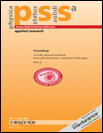Interface investigations of iron and cobalt metallized porous silicon: AES and FTIR analyses
Abstract
Porous silicon (PS) is characterized by a very large surface that is very reactive with the external environment. In this work, the chemical composition of the internal surface of both freshly anodically formed and electroplated PS with Fe and Co metals was studied. The samples were analyzed by scanning electron microscopy (SEM), Fourier transform infrared absorption spectroscopy (FTIR) and Auger electron spectroscopy (AES) combined to sputter depth profiling. Mesoporous structures with different morphologies were obtained in p-type Si(100) anodized in ethanoic hydrofluoric acid solutions. We showed that the surface of as-prepared PS is practically oxide-free and H-terminated, whereas the metal deposition process oxidizes the pore walls. Nevertheless, silicon atoms from PS surface are likely bonded to iron and cobalt ones.




